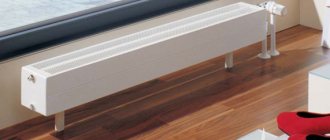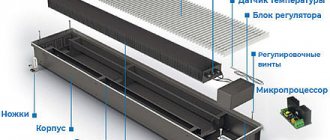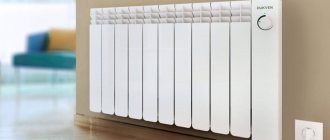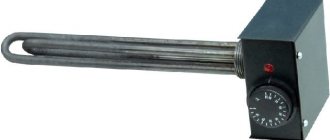The convection type of residential heating is especially popular among home owners who want to save their family budget. Unlike the traditional one, the method will require the installation of special radiators. Let's look at the benefits of heating convectors - water, gas and powered by electricity.
Trench convectors Source prom.st
What is convection
The operating principle of convector heating is based on the natural movement of air masses. Everyone knows that when air is heated, it immediately begins to rise to the top. Having reached the top point (under the ceiling), the hot flows have nowhere to move further, and they begin to give off heat to the surrounding atmosphere.
Having cooled, the air masses fall down (towards the floor). There they again enter the heater and the process repeats again. In order for circulation to accelerate, a large area of the heating battery is needed. This is where the special design of the convector comes to the rescue.
Convector-type heating radiators consist of many steel or aluminum plates, which are located at a short distance from each other. They are placed either on a coolant pipe or on a special heating element. Therefore, even a small heater has a very large heat transfer area.
Convector design Source teplo-klimat.com.ua
From direct contact with a hot pipeline (or heating element), the plates completely assume the temperature of the source. The air between them heats up in a very short time and rushes upward through the grille. Its place is immediately taken by the cold atmosphere from the floor. This process is so fast that even a huge room warms up in literally a matter of minutes.
A convector heater can have only one pipe, which runs along the entire body, turns around and returns back. In this case, the model is longer in length to increase its performance. Power can also be increased by placing a coil with plates in a more compact housing.
The main requirement for operation
The principle of operation of a convector for heating a private house or apartment is the passage of air flow through the equipment body. This phenomenon eliminates the possibility of covering the radiator with anything for the purpose of warming or drying. If you block the perforations or slots in the upper end of the box, the heated air will not be able to spread with proper efficiency. In the case of a convector-type electric heater, humidity can be a detrimental factor for the heating element or a person. This is justified by the fact that water is an excellent conductor of current.
Heat exchanger
The material used to make the radiator itself plays a very important role. Thermal conductivity is the main property on which the rate of heating of the room and its quality depend. Other characteristics already play a secondary role.
The pipeline is made from:
- copper;
- aluminum;
- copper-aluminum alloy;
- become.
Copper heat exchanger Source norenthermal.com
Copper is considered the best. This non-ferrous metal has sufficient strength and conducts heat well. But it costs too much. Aluminum is cheaper and also has good thermal conductivity. But this material is easily deformed. This may result in reduced heating efficiency. Therefore, for lovers of the golden mean, it is better to pay attention to an alloy of these metals. Steel is the most durable and inexpensive, but heat transfer is low.
Plates also play a significant role in heating the room. They are also made from all of the above mentioned metals. But they may have one feature, which is their shape. In addition to the usual smoothness and evenness, they can be made in various configurations. For example, wavy or meander type.
Various curvatures and corrugations increase the area of the element. As a result, heat transfer increases compared to smooth lamellas. The number of plates inside the radiator depends on the volume of the room that needs to be heated.
Aluminum plates on a copper pipe Source wterm.cz
You should carefully inspect the radiator when purchasing and check the fit of the lamellas to the coolant pipe or heating element. Even a small gap significantly increases heat loss. If literally every connection suffers from such a defect, then the efficiency of this unit is catastrophically reduced.
And just a few words about the case. If it is, it must have upper and lower grilles. So that the air can freely enter inside for subsequent heating and come out already hot. You can often see radiators without a casing or covered with a steel box. True, this mostly applies to devices located in technical rooms.
And since the entire heating principle is based on air circulation, the housing is often excluded from the heating process. Modern convector-type batteries are most often covered with a casing made of heat-resistant plastic with mandatory grilles. This increases the safety of the device, especially for children. After all, even if you touch the heater very closely, it is impossible to get burned on it.
Floor convector Source verano-konwektor.com
Comparative table of technical characteristics of oil and covector heaters
| Options | Oil heater | Convector heater |
| Economical | - Low economical. | +Approximately 25% more economical. |
| Heating time | + - Conventional models heat up for a long time, but those equipped with fans quickly. | —Heats the room for a long time. |
| Comfort to use | -Average. | +Both floor and wall models are more convenient. |
| Safety | —High surface temperature (but there are models with a protective casing); If the operating rules are violated, there is a risk of explosion. | +The surface of the convector is not subjected to strong heating; can be left unattended. |
| Life time | -Average | +Big |
| Environmental friendliness | —Due to convection, it raises dust particles | —Due to convection, it raises dust particles |
And based on the totality of all this, when deciding whether to choose a convector or an oil heater, you can clearly conclude: of course, a convector. Lightweight, compact, silent and safe, these heating devices are gradually replacing heavy, short-lived devices filled with hot oil from apartments and offices. So we can say that oil heaters have almost become a thing of the past in the matter of heating rooms. The only thing is that models of oil heaters equipped with fans are able to heat the room somewhat faster, but the process of heating its surface itself remains long. See below for detailed materials on choosing these heaters.
(no votes yet)
Air circulation
Due to the very close location of the lamellas to each other, the air passing between them from bottom to top heats up almost instantly. But convection itself proceeds much more slowly. This is due to the natural process of movement of air masses, although they become hot.
There is a way to greatly enhance an already effective system. To do this, a fan is located inside the case, which immediately expels air through the upper grille. And in the technical data sheet for the heater, the markings must indicate what type the device belongs to. The extra capital "P" stands for forced convection. The letter "E" is natural.
But increasing the heating rate also has a downside:
- The device must also be connected to the mains.
- Additional financial expense for electricity, although not large.
- Even the quiet rustle of the impeller can become annoying over time.
Window convector with fan Source prom.st
Devices with forced air circulation are equipped with two types of fans. Axial ones are placed from the end. They drive the flow along the entire heat exchanger. Tangential ones are distinguished by blades that form a cylinder. Therefore, the impeller is made according to the dimensions of the heat exchanger and installed behind it so that the fan blows hot air over the entire area.
See also: Catalog of companies that specialize in engineering systems (heating, water supply, sewerage and others) and related work
Operating principle of an oil cooler
Everything here is arranged quite simply. The oil cooler is a hermetically sealed reservoir filled with mineral oil. An electric heater is also located inside the structure. As a result of the operation of the heating element, the oil temperature rises, and then the walls of the tank heat up. The room is heated.
To prevent the oil from boiling, the system is equipped with a special sensor that controls the temperature. In addition, some models have horizontal control. This means that if the radiator accidentally tips over and the heating element is out of the oil environment, the automation will instantly turn off the device.
Oil radiators are very easy to use. No knowledge is required here. You just need to plug the plug into the outlet, press the power button and move the device closer. Some manufacturers equip their models with a timer that allows the device to automatically turn on at a certain time. This is very convenient if you want, for example, to return from work to an already well-warmed room. At the same time, the radiator remains turned off throughout the day and does not waste electricity.
Advantages and disadvantages of convectors
It should be noted right away that convector heating batteries are not universal. For example, if the ceilings in the room are too high, then the efficiency of such heating decreases significantly. The temperature difference between the upper layers and those located below is too large.
As a rule, such heating is installed in buildings not connected to the gas main. And the ideal option in this case is a dacha. Equipping it with an electric model will bring maximum economic benefits. Such heating in winter greenhouses is also productive and profitable.
Convector for winter garden Source purmo.com
Main advantages of convectors:
- Suitable for any premises, both residential and other purposes.
- They do not burn oxygen and practically do not change humidity.
- Do not take up useful space.
- Their low weight allows them to be mounted on a wall or built into the floor or furniture elements.
- Easy installation, especially for electrical units.
- Absolutely fireproof.
- Wide selection of types and sizes.
- Well suited for creating thermal curtains.
The latter circumstance will be an undoubted advantage in rooms with panoramic windows. If you place a convector under them, condensation will not appear in winter. Often a small model is built into the floor right next to the front door and then cold air is simply not able to penetrate from the street. This option works great for high traffic areas.
Another advantage is the ability of convectors to cool the room. True, it is difficult to organize this in everyday conditions. Yes, and it is impractical, since it is necessary to connect the device to running water or a chiller. But at industrial facilities this interesting feature is often used.
Convector with the ability to cool the air Source cloudfront.net
Convector-type radiators also have a number of disadvantages:
- Not suitable for rooms where humidity cannot be changed even slightly.
- Creates a feeling of overheated air.
- Capable of picking up dust from the floor.
- An incorrectly chosen installation location will cause drafts.
- One device will heat only one room.
From the above we can draw a simple conclusion. A convector will greatly help out where you need to quickly and inexpensively set up heating. And usually such heating is used in rooms where people come for a while. After all, a convector is not capable of accumulating heat. If the device is disconnected from the heat source, it cools down very quickly. It is also good to use as an additional heater when the main heating cannot cope with severe street frosts.
What heats better, a convector or an oil radiator?
Significant differences in the operation of a convector from an oil radiator affect the thermal characteristics and thermal efficiency of the devices.
Thermal characteristics of oil radiators
The main advantage of an oil heater over an electric convector is its high heating temperature. If the radiator design has a fan heater, the room can be warmed up quickly enough.
The heater operates almost silently. The optimal solution would be to use a heating device in country houses. Maximum heating area 20-25 m².
Thermal efficiency of convectors
The convector is distinguished by a low heating temperature, no more than 60°C, creating a favorable microclimate. The device does not dry the air, but to warm up the room it will take longer than an oil radiator with a fan heater, but only if the heating element of the latter is heated to the required temperature. The performance of convectors is sufficient to provide heating of a room over 100 m².
The electric convector is distinguished by the best thermal characteristics and performance.
Types of convectors and their designs
The simplest device consists of a copper tube bent in the shape of the English letter “U”. Two parallel pipes are connected to each other by metal plates. And the more of them are used in the design, the more productive the convector radiator will become.
Modern design for a convector Source konvektor-ukraine.in.ua
How to reduce costs
To keep heating costs at home lower, it is necessary to ensure minimal heat loss in the room.
Most of the heat escapes through doors, windows, attics and walls. Therefore, if the task is to reduce heat loss, first of all you should:
- Insulate windows by installing triple glazing or reducing window openings (or the number of windows). This will provide up to 10-20% heat retention.
- Insulate the doors. Or replace them with new ones with good thermal insulation.
- Insulate the attic. This will provide about 5-10% more heat.
- Insulate the walls by covering them with high-quality thermal insulation material. This gives another plus 20-30% or even 70% of heat.
Features of convectors
As already mentioned, the design of the heat exchanger itself is the same for all types of this equipment. But heat can be obtained from various energy sources. And therefore you need to know some of the nuances associated with the installation and use of each of them.
Mermen
Water heating is included in the category of universal systems. It can be installed either on an autonomous boiler that uses any type of fuel, or by connecting to a centralized mains. Therefore, water convector heating batteries are cost-effective and suitable for any premises. Both residential and commercial.
Water convector Source budujemydom.pl
An important advantage of a water convection system is the ability to regulate heating in the off-season. It happens that the cold outside the window suddenly gives way to warming. And then the room becomes simply stuffy from the heat. In this case, it is enough to shut off the coolant supply to the convector, and the heater will immediately stop producing heat.
For this purpose, the circuit is equipped with a thermoregulation system. Many models are equipped with a thermostatic valve. And if it is missing, then you can buy it and easily install it. You can even mount an electronic control with ambient temperature sensors on it. And then the regulation process will take place automatically.
There are the simplest models in which a special damper is installed. It simply blocks the path for hot air, and convection does not occur. For many users, this cheap option is considered the most convenient.
Electronic convector control Source amazon.com
Features of the convector heating system
The operating principle of convector heating
The very first convector heating batteries were traditional stoves. Thermal energy from their surface is transferred to the room. In this case, natural convection of air flows occurs - with a higher temperature they rise upward, creating heat circulation.
However, the efficiency of their work remains extremely low - the efficiency indicator did not exceed 25-30%. Therefore, convector heating boilers have been developed that transfer energy more efficiently. For this purpose, their design includes additional convector surfaces that improve circulation and, accordingly, the heating rate of the house.
How does convector heating at home differ from conventional heating?
- No pipelines. This reduces the primary costs of organizing heating;
- Possibility of installing local heating points - autonomous radiators. Most often this is done for dachas or houses with a small area, or apartments;
- Operational regulation of energy consumption to optimize temperature conditions.
The disadvantages of such a system include the complexity of the organization for buildings with a large area. Even if you install convector water heating consisting of autonomous radiators, it is problematic to create a single control unit. But there are exceptions - modern gas convector heating boilers. These are common models that can be installed in piping systems. The parameters for choosing such boilers are the same as when designing traditional heating systems.
The amount of energy generated in convector-type heating devices directly depends on the area of the heat exchanger
This is what you need to pay attention to first.
Video description
The video will demonstrate the best electric convectors:
Gas
A gas convector can be called solely because the boiler uses a certain type of fuel. Because a closed heating circuit uses water as a coolant. Therefore, all its main characteristics are similar to convector water heating radiators.
Gas equipment has a low cost, but it is more cumbersome than other types. And there are two serious problems for its use. Permission must be obtained. And for this you will have to correctly draw up documents and obtain the necessary signatures.
But use will be allowed only after the chimney has been installed and other conditions have been met. For example, if you need to heat several rooms, you will not only have to buy a convector for each, but also install separate gas pipeline lines coming from the street.
Such units can use not only main gas. They can also be connected to a balloon. A convector, the heating battery of which runs on liquefied gas, is perfect for a summer cottage.
Difference between convection heater and radiator
The heating system only reminds itself with the arrival of cold weather. However, you need to prepare the sled in the summer. During the cold season, comfort indoors, be it a house, apartment or office, is vital. Heat supply is a serious issue, especially in the choice of radiators.
Designation
A heating device is a radiator in the middle of which a coolant (water, antifreeze) moves. The heating device returns heat to the room using infrared, in other words thermal, radiation. Heating of the room occurs from the window into the room. According to their design, heating devices are sectional, tubular and panel. The level of heating of the room depends on the number of attached sections or panels. Today, our usual cast iron sectional heating devices are being replaced with metal or bimetallic devices.
The material from which the radiator is made plays an important role in heat transfer
Heating device
The radiator design is a radiator that transfers heat using convection. Convection is a physical phenomenon in which air flows through the heater, increases in volume and enters the space of the room, while cooler air occupies the free space. Air circulation occurs in a real way, creating a temperature difference. In the design of a convector heater, the important elements are: a channel through which the coolant moves, and grates or plates through which air passes.
Radiator design to contents ^
When comparing heating devices and convector heaters, let’s turn our attention to the places of their use. So, for example, water heating radiators are perfect for office and industrial premises with an increased glazing area, and also with a very high level of moisture (greenhouses, semi-houses, semi-gardens, swimming pools)
Panel radiators made of steel are very often installed in cottages and cottages. To heat apartments in houses with centralized heating, today it is proposed to install bimetal radiators.
It is believed that in terms of heat output, heating devices give off more heat than convector heaters. This is due to the surface area, which is involved in the heat transfer process. Heating devices provide more constant heating of the air, and convector heaters can create a draft in the room. This phenomenon occurs due to the movement of air from bottom to top. And if the device does not cover the width of the window, then the air also moves from the window into the room. From a safety point of view, convector heaters are considered less hot than, say, a cast iron radiator. But due to the properties of the structure, dust collects in the design radiators.
Conclusions TheDifference.ru
- The heating device has a very high heat output;
- The heating device is more economical to operate; the radiator design requires more heat input;
- A heating device will cost much more than a radiator design;
- The heating device is more environmentally friendly, the design of the radiator collects and drives away dust;
- The heating device is more powerful and larger; the radiator design is more compact and can be built into walls and floors.
Tips for choosing convectors
Here are the main criteria to pay attention to:
- When choosing an electrical device or a device with forced circulation, it is necessary to provide in advance a place for connecting to the network.
- When choosing devices that require installation (wall-mounted, in-floor), you need to compare their dimensions with the installation location.
- The housing of wall-mounted models must be protected from direct sunlight.
- When installing on a plasterboard partition, you must either choose the lightest models or strengthen the wall.
- Users note that mechanical control is no worse than electronic control. Therefore, if there is a need to save money, you can stop there.
- A built-in fan will be a must for rooms with high traffic.
- A good convector kit should include: shut-off valve, Mayevsky tap, thermostat and fittings.
- The more heat exchanger plates a device has, the more efficient the heating.
- Irritable people are better off not purchasing electric models due to unexpected and constant clicking of the thermostat.
- For a child's room you need to choose a unit with a power reserve, but for an office it will be suitable with slightly lower performance.
- The most reliable manufacturers of electric convectors are Electroluxe, Scarlet, Polaris. Gas - ATON, Hosseven, Gorenje, Alpine, Karma.
Oil type heaters
These devices are very widely used to increase the air temperature in an apartment or house. Installing them is extremely simple; no special skills or knowledge are required. Plug the device into the outlet, placing it closer to the heated area - and you're done. Thanks to the simplest possible design, breakdowns of the device's electrical circuit are unlikely.
Several models of oil radiators - the one on the far left is equipped with a fan.
The design of the oil cooler is based on a metal reservoir with mineral oil poured inside it. The oil, in turn, contains a heating element. As a rule, a device of this type is equipped with a rheostat for temperature control, a compartment for the power cord and electrical protection against overheating. Sometimes the heater also has a sensor that detects deviation from the horizontal. This allows you to automatically turn off a device that has tipped over. Oil radiators are also splash-proof.
Oil radiators are equipped with a handle for easy movement around the apartment.
The heaters are equipped with swivel wheels.
The cord compartment is designed to store the power cable when not in use.
Advantages of the oil device:
- Low price;
- Quiet operation;
- Ease of movement over various distances, for example, from room to room.
To determine how much power the device will need to make the room warm, we will use the following rule. If the ceiling height does not exceed three meters, then to heat 10 square meters of space you need a radiator with a capacity of 1 kilowatt. Basically, similar devices are produced with a power range from 1 to 2.5 kilowatts.
The device usually has a thermostat that automatically sets the desired temperature, maintaining it at the same level. Models equipped with a timer are very convenient - it will turn on the heater at the appointed hour. For example, you can schedule heating for the morning or evening, when all household members arrive from work. Thus, the timer allows you to save a fair amount of electricity, which is very expensive today.
Heater with electronic control system.
Mechanical control system.
Briefly about the main thing
Convector heating is one of the most effective and economical ways to heat a home. Because even the most compact device has a very large heat transfer area. Using the natural process of air circulation and enhancing it with the built-in fan, you can warm up even a large room in a matter of minutes.
When choosing a convector for your home, first of all you need to decide from which source the heat will flow to it. After all, convectors are water, gas and electric. And each model has its own characteristics. Particular attention should be paid to the heat exchanger. And it is better to give preference to something made of non-ferrous metal.
How to calculate the required number of devices
As a rule, to calculate the power and number of devices required to heat a room, a formula is used based on 100 W per 1 sq.
m. For example, for a room of 15 square meters. m requires equipment with a power of 1.5 kW. It is best to install convectors under the window - 1 convector for each of them. This will allow you to heat the room with maximum efficiency. Accordingly, for a room of 15 square meters. m and three windows, it is best to purchase 3 convectors with a power of 0.5 kW each and install them under the windows to prevent the penetration of cold air into the room.











